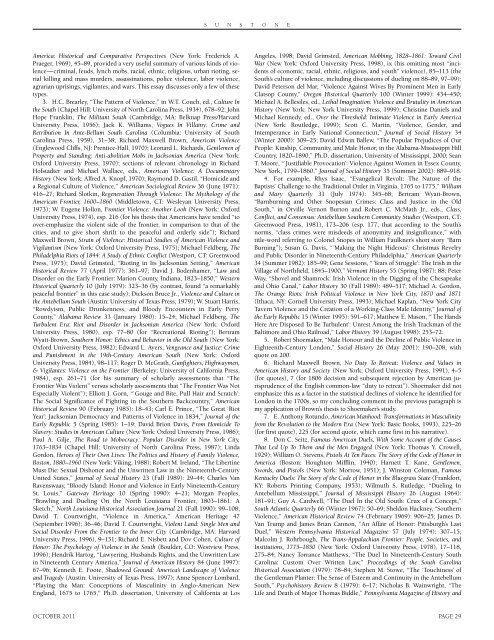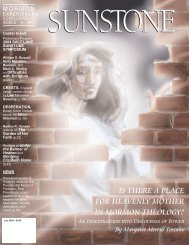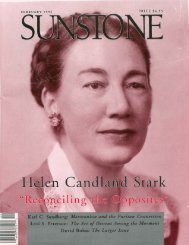Download Entire Issue PDF - Sunstone Magazine
Download Entire Issue PDF - Sunstone Magazine
Download Entire Issue PDF - Sunstone Magazine
Create successful ePaper yourself
Turn your PDF publications into a flip-book with our unique Google optimized e-Paper software.
S U N S T O N E<br />
America: Historical and Comparative Perspectives (New York: Frederick A.<br />
Praeger, 1969), 45–89, provided a very useful summary of various kinds of violence—criminal,<br />
feuds, lynch mobs, racial, ethnic, religious, urban rioting, serial<br />
killing and mass murders, assassinations, police violence, labor violence,<br />
agrarian uprisings, vigilantes, and wars. This essay discusses only a few of these<br />
types.<br />
3. H.C. Brearley, “The Pattern of Violence,” in W.T. Couch, ed., Culture In<br />
the South (Chapel Hill: University of North Carolina Press, 1934), 678–92; John<br />
Hope Franklin, The Militant South (Cambridge, MA: Belknap Press/Harvard<br />
University Press, 1956); Jack K. Williams, Vogues In Villainy: Crime and<br />
Retribution In Ante-Bellum South Carolina (Columbia: University of South<br />
Carolina Press, 1959), 31–38; Richard Maxwell Brown, American Violence<br />
(Englewood Cliffs, NJ: Prentice-Hall, 1970); Leonard L. Richards, Gentlemen of<br />
Property and Standing: Anti-abolition Mobs in Jacksonian America (New York:<br />
Oxford University Press, 1970); sections of relevant chronology in Richard<br />
Hofstadter and Michael Wallace, eds., American Violence: A Documentary<br />
History (New York: Alfred A. Knopf, 1970); Raymond D. Gastil, “Homicide and<br />
a Regional Culture of Violence,” American Sociological Review 36 (June 1971):<br />
416–27; Richard Slotkin, Regeneration Through Violence: The Mythology of the<br />
American Frontier, 1600–1860 (Middletown, CT: Wesleyan University Press,<br />
1973); W. Eugene Hollon, Frontier Violence: Another Look (New York: Oxford<br />
University Press, 1974), esp. 216 (for his thesis that Americans have tended “to<br />
over-emphasize the violent side of the frontier, in comparison to that of the<br />
cities, and to give short shrift to the peaceful and orderly side”); Richard<br />
Maxwell Brown, Strain of Violence: Historical Studies of American Violence and<br />
Vigilantism (New York: Oxford University Press, 1975); Michael Feldberg, The<br />
Philadelphia Riots of 1844: A Study of Ethnic Conflict (Westport, CT: Greenwood<br />
Press, 1975); David Grimsted, “Rioting in Its Jacksonian Setting,” American<br />
Historical Review 77 (April 1977): 361–97; David J. Bodenhamer, “Law and<br />
Disorder on the Early Frontier: Marion County, Indiana, 1823–1850,” Western<br />
Historical Quarterly 10 (July 1979): 323–36 (by contrast, found “a remarkably<br />
peaceful frontier” in this case study); Dickson Bruce Jr., Violence and Culture in<br />
the Antebellum South (Austin: University of Texas Press, 1979); W. Stuart Harris,<br />
“Rowdyism, Public Drunkenness, and Bloody Encounters in Early Perry<br />
County,” Alabama Review 33 (January 1980): 15–24; Michael Feldberg, The<br />
Turbulent Era: Riot and Disorder in Jacksonian America (New York: Oxford<br />
University Press, 1980), esp. 77–80 (for “Recreational Rioting”); Bertram<br />
Wyatt-Brown, Southern Honor: Ethics and Behavior in the Old South (New York:<br />
Oxford University Press, 1982); Edward L. Ayers, Vengeance and Justice: Crime<br />
and Punishment in the 19th-Century American South (New York: Oxford<br />
University Press, 1984), 98–117; Roger D. McGrath, Gunfighters, Highwaymen,<br />
& Vigilantes: Violence on the Frontier (Berkeley: University of California Press,<br />
1984), esp. 261–71 (for his summary of scholarly assessments that “The<br />
Frontier Was Violent” versus scholarly assessments that “The Frontier Was Not<br />
Especially Violent”); Elliott J. Gorn, “`Gouge and Bite, Pull Hair and Scratch’:<br />
The Social Significance of Fighting in the Southern Backcountry,” American<br />
Historical Review 90 (February 1985): 18–43; Carl E. Prince, “The Great `Riot<br />
Year’: Jacksonian Democracy and Patterns of Violence in 1834,” Journal of the<br />
Early Republic 5 (Spring 1985): 1–19; David Brion Davis, From Homicide To<br />
Slavery: Studies in American Culture (New York: Oxford University Press, 1986);<br />
Paul A. Gilje, The Road to Mobocracy: Popular Disorder in New York City,<br />
1763–1834 (Chapel Hill: University of North Carolina Press, 1987); Linda<br />
Gordon, Heroes of Their Own Lives: The Politics and History of Family Violence,<br />
Boston, 1880–1960 (New York: Viking, 1988); Robert M. Ireland, “The Libertine<br />
Must Die: Sexual Dishonor and the Unwritten Law in the Nineteenth-Century<br />
United States,” Journal of Social History 23 (Fall 1989): 29–44; Charles Van<br />
Ravenswaay, “Bloody Island: Honor and Violence in Early Nineteenth-Century<br />
St. Louis,” Gateway Heritage 10 (Spring 1990): 4–21; Morgan Peoples,<br />
“Brawling and Dueling On the North Louisiana Frontier, 1803–1861: A<br />
Sketch,” North Louisiana Historical Association Journal 21 (Fall 1990): 99–108;<br />
David T. Courtwright, “Violence in America,” American Heritage 47<br />
(September 1996): 36–46; David T. Courtwright, Violent Land: Single Men and<br />
Social Disorder From the Frontier to the Inner City (Cambridge, MA: Harvard<br />
University Press, 1996), 9–151; Richard E. Nisbett and Dov Cohen, Culture of<br />
Honor: The Psychology of Violence in the South (Boulder, CO: Westview Press,<br />
1996); Hendrik Hartog, “Lawyering, Husbands Rights, and the Unwritten Law<br />
in Nineteenth Century America,” Journal of American History 84 (June 1997):<br />
67–96; Kenneth E. Foote, Shadowed Ground: America’s Landscape of Violence<br />
and Tragedy (Austin: University of Texas Press, 1997); Anne Spencer Lombard,<br />
“Playing the Man: Conceptions of Masculinity in Anglo-American New<br />
England, 1675 to 1765,” Ph.D. dissertation, University of California at Los<br />
Angeles, 1998; David Grimsted, American Mobbing, 1828–1861: Toward Civil<br />
War (New York: Oxford University Press, 1998), ix (his omitting most “incidents<br />
of economic, racial, ethnic, religious, and youth” violence), 85–113 (the<br />
South’s culture of violence, including discussions of dueling on 88–89, 97–99);<br />
David Peterson del Mar, “Violence Against Wives By Prominent Men in Early<br />
Clatsop County,” Oregon Historical Quarterly 100 (Winter 1999): 434–450;<br />
Michael A. Bellesiles, ed., Lethal Imagination: Violence and Brutality in American<br />
History (New York: New York University Press, 1999); Christine Daniels and<br />
Michael Kennedy, ed., Over the Threshold: Intimate Violence in Early America<br />
(New York: Routledge, 1999); Scott C. Martin, “Violence, Gender, and<br />
Intemperance in Early National Connecticut,” Journal of Social History 34<br />
(Winter 2000): 309–25; David Edwin Ballew, “The Popular Prejudices of Our<br />
People: Kinship, Community, and Male Honor, in the Alabama-Mississippi Hill<br />
Country, 1820–1890,” Ph.D. dissertation, University of Mississippi, 2000; Sean<br />
T. Moore, “`Justifiable Provocation’: Violence Against Women in Essex County,<br />
New York, 1799–1860,” Journal of Social History 35 (Summer 2002): 889–918.<br />
4. For example, Rhys Isaac, “Evangelical Revolt: The Nature of the<br />
Baptists’ Challenge to the Traditional Order in Virginia, 1765 to 1775,” William<br />
and Mary Quarterly 31 (July 1974): 345–68; Bertram Wyatt-Brown,<br />
“Barnburning and Other Snopesian Crimes: Class and Justice in the Old<br />
South,” in Orville Vernon Burton and Robert C. McMath Jr., eds., Class,<br />
Conflict, and Consensus: Antebellum Southern Community Studies (Westport, CT:<br />
Greenwood Press, 1981), 173–206 (esp. 177, that according to the South’s<br />
norms, “class crimes were misdeeds of anonymity and insignificance,” with<br />
title-word referring to Colonel Snopes in William Faulkner’s short story “Barn<br />
Burning”); Susan G. Davis, “`Making the Night Hideous’: Christmas Revelry<br />
and Public Disorder in Nineteenth-Century Philadelphia,” American Quarterly<br />
34 (Summer 1982): 185–99; Gene Sessions, “`Years of Struggle’: The Irish in the<br />
Village of Northfield, 1845–1900,” Vermont History 55 (Spring 1987): 88; Peter<br />
Way, “Shovel and Shamrock: Irish Violence in the Digging of the Chesapeake<br />
and Ohio Canal,” Labor History 30 (Fall 1989): 489–517; Michael A. Gordon,<br />
The Orange Riots: Irish Political Violence in New York City, 1870 and 1871<br />
(Ithaca, NY: Cornell University Press, 1993); Michael Kaplan, “New York City<br />
Tavern Violence and the Creation of a Working-Class Male Identity,” Journal of<br />
the Early Republic 15 (Winter 1995): 591–617; Matthew E. Mason, “`The Hands<br />
Here Are Disposed To Be Turbulent’: Unrest Among the Irish Trackman of the<br />
Baltimore and Ohio Railroad,” Labor History 39 (August 1998): 253–72.<br />
5. Robert Shoemaker, “Male Honour and the Decline of Public Violence in<br />
Eighteenth-Century London,” Social History 26 (May 2001): 190–208, with<br />
quote on 200.<br />
6. Richard Maxwell Brown, No Duty To Retreat: Violence and Values in<br />
American History and Society (New York: Oxford University Press, 1991), 4–5<br />
(for quotes), 7 (for 1806 decision and subsequent rejection by American jurisprudence<br />
of the English common-law “duty to retreat”). Shoemaker did not<br />
emphasize this as a factor in the statistical declines of violence he identified for<br />
London in the 1700s, so my concluding comment in the previous paragraph is<br />
my application of Brown’s thesis to Shoemaker’s study.<br />
7. E. Anthony Rotundo, American Manhood: Transformations in Masculinity<br />
from the Revolution to the Modern Era (New York: Basic Books, 1993), 225–26<br />
(for first quote), 225 (for second quote, which came first in his narrative).<br />
8. Don C. Seitz, Famous American Duels, With Some Account of the Causes<br />
That Led Up To Them and the Men Engaged (New York: Thomas Y. Crowell,<br />
1929); William O. Stevens, Pistols At Ten Paces: The Story of the Code of Honor in<br />
America (Boston: Houghton Mifflin, 1940); Harnett T. Kane, Gentlemen,<br />
Swords, and Pistols (New York: Morrow, 1951); J. Winston Coleman, Famous<br />
Kentucky Duels: The Story of the Code of Honor in the Bluegrass State (Frankfort,<br />
KY: Roberts Printing Company, 1953); Wilmuth S. Rutledge, “Dueling In<br />
Antebellum Mississippi,” Journal of Mississippi History 26 (August 1964):<br />
181–91; Guy A. Cardwell, “The Duel In the Old South: Crux of a Concept,”<br />
South Atlantic Quarterly 66 (Winter 1967): 50–69; Sheldon Hackney, “Southern<br />
Violence,” American Historical Review 74 (February 1969): 906–25; James D.<br />
Van Trump and James Brian Cannon, “An Affair of Honor: Pittsburgh’s Last<br />
Duel,” Western Pennsylvania Historical <strong>Magazine</strong> 57 (July 1974): 307–15;<br />
Malcolm J. Rohrbough, The Trans-Appalachian Frontier: People, Societies, and<br />
Institutions, 1775–1850 (New York: Oxford University Press, 1978), 17–118,<br />
275–84; Nancy Torrance Matthews, “The Duel In Nineteenth-Century South<br />
Carolina: Custom Over Written Law,” Proceedings of the South Carolina<br />
Historical Association (1979): 78–84; Stephen M. Stowe, “The `Touchiness’ of<br />
the Gentleman Planter: The Sense of Esteem and Continuity in the Antebellum<br />
South,” Psychohistory Review 8 (1979): 6–17; Nicholas B. Wainwright, “The<br />
Life and Death of Major Thomas Biddle,” Pennsylvania <strong>Magazine</strong> of History and<br />
OCTOBER 2011 PAGE 29

















